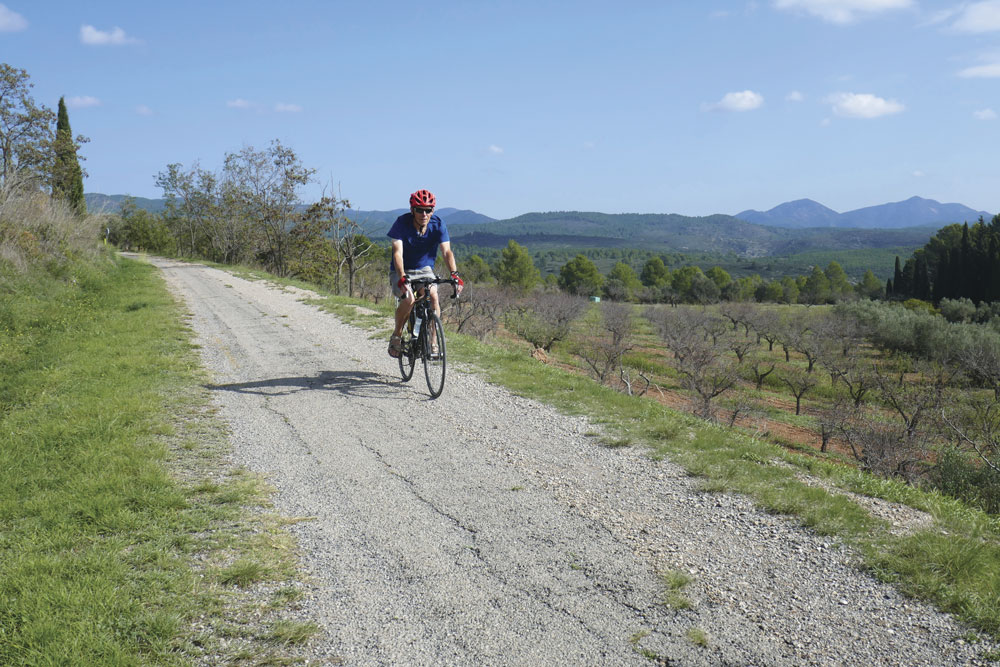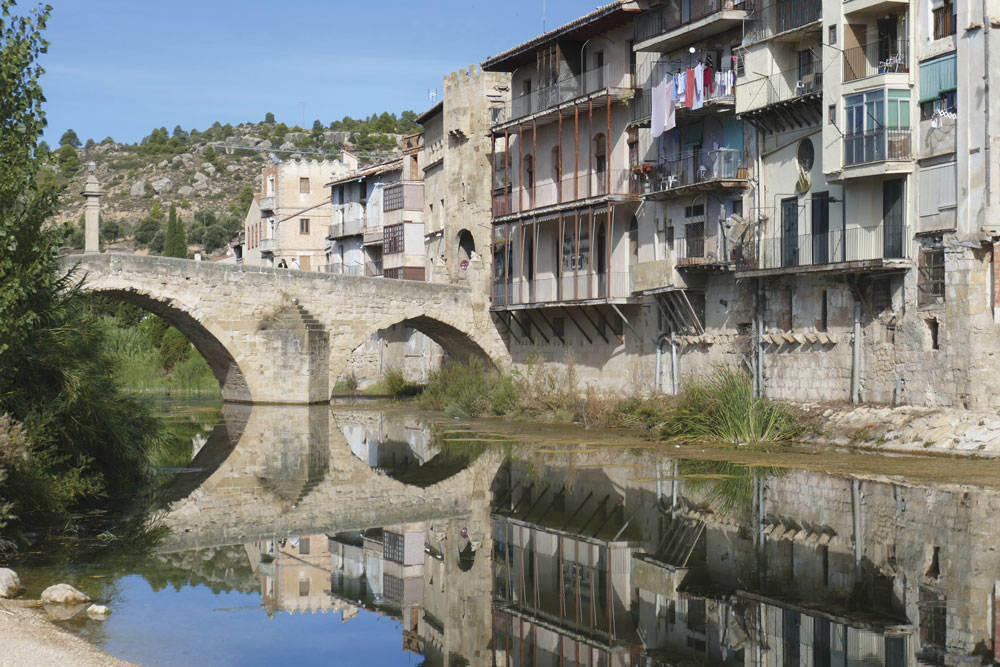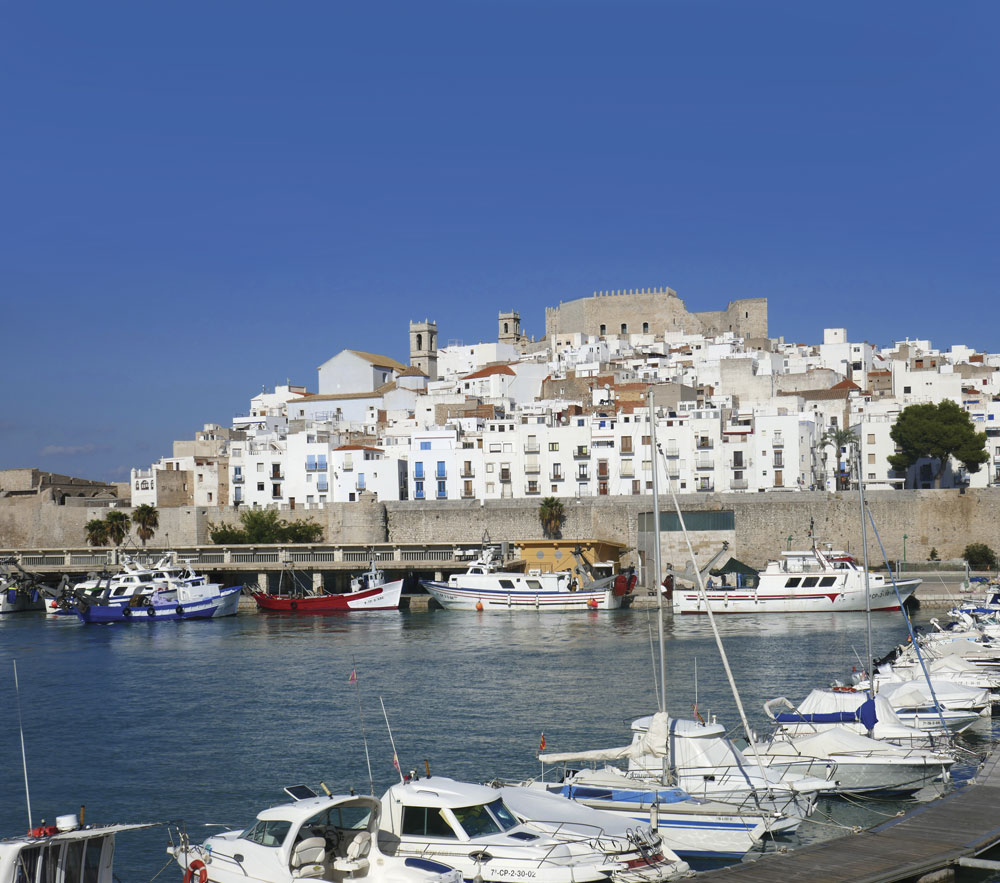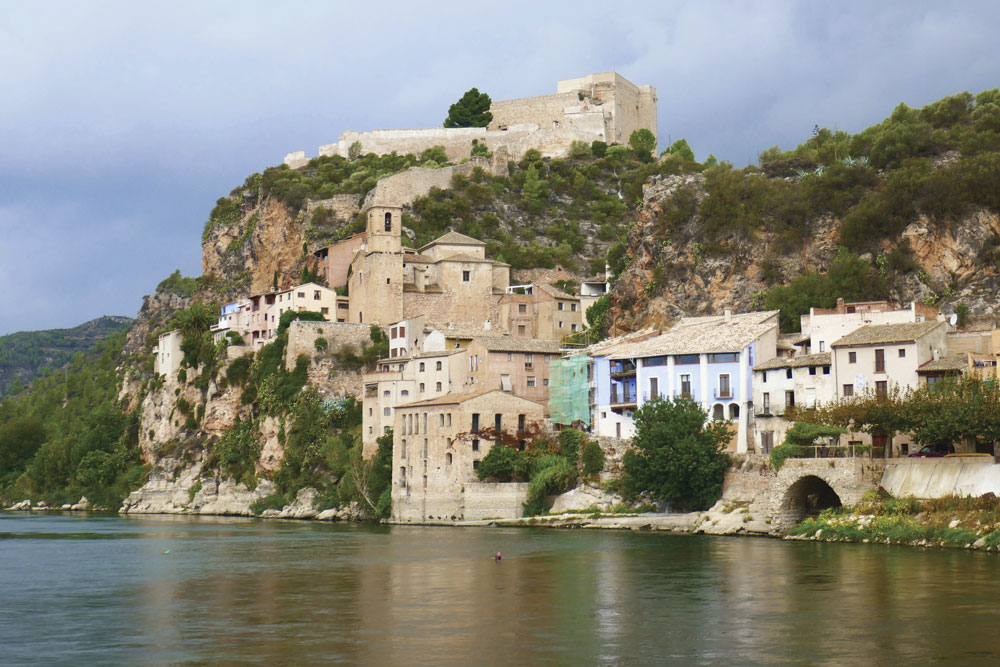Come to Spain by campervan, stay for the cycling
See also: Campervan: Travel and Destination Guide
Words and Photos by Carol Kubicki
When I dream about cycling it is always sunny, I am wearing shorts and T-shirt, with not a car in sight. The hills are never too steep and ahead is a welcoming café.
I found this cycling heaven where the regions of Aragón, Catalonia and València meet in a delightful corner of Spain.
Exploring these areas by motorhome or campervan is fantastic but on two long vías verdes (off-road cycle routes) there is also relaxed rural cycling.
Near to the coast, this is an area rich in culture, history and gastronomy – perfect for combining cycling on the Val de Zafán and Ojos Negros vías verdes with the beach.
Carlos provided a friendly welcome to his campsite near Valderrobres in Aragón. He showed off the excellent facilities and enthusiastically annotated maps with cycling routes along lanes and the nearby Val de Zafán Vía Verde. “This is the most beautiful part of the Matarraña region,” Carlos eagerly assured me.
The Matarraña is certainly gorgeous and, being tucked away off the main roads, is easily missed. Following Carlos’ recommendation, we headed out on the bikes for the camino natural (track) along the valley.
What had got lost in translation was the need to tackle stepping stones over the Matarraña river while carrying a bike. My husband, Anthony, is capable of balancing with a heavy bike under his arm; I took my sandals off and paddled!
The historic riverside town of Valderrobres is a few kilometres along the camino path. With a medieval bridge and a monumental gate, the old town took me back in time as we wandered the cool, shady streets inside the walls. Climbing between the charming stone houses, some painted powder blue, we reached the fourteenth century castle at the top of the town.
After coffee we followed the Matarraña upstream to the village of Beceite. As we climbed higher the track became overgrown and we were pushing more than cycling.

We took the chance to join the road, which winds up the valley, passing some of Beceite’s abandoned paper mills. This remote village once made the paper for Spanish bank notes. The undulating lane to the reservoir between tidy olive and almond groves was idyllic and we returned along a pretty wooded gorge.
Ready for a longer ride the following day, we once again crossed the lovely Matarraña in our own way and took the camino natural along the tranquil valley before climbing up to the village of Torre del Compte for coffee.
Wheeling downhill to the traffic-free vía verde, we followed this steadily uphill through an agricultural landscape.
The Matarraña is proud of its produce and, throughout the year, you might stumble upon a wine, olive, livestock or mushroom festival.
Stopping at each viaduct to enjoy the views I knew I was in cycling paradise! But, returning across the river, Anthony’s rear bike tyre deflated with a puncture.
Back at our pitch, we were celebrating our good fortune that the puncture had happened so close to home.
As the campsite was almost empty we were surprised to find a friendly Spanish family had camped next door, pitching so their caravan door faced ours and their two (yes, two!) awnings nudged our space. We sat with a brew watching them unpack a fridge, microwave and boxes of stuff; more than we’ll ever own! The decision to decamp was made.

We only shifted our Blue Bus a short distance to Arnes in the Catalonia region. This hilly area is a denominación de origen and produces great wine and olive oil. From our campsite pitch we gazed over an olive grove to the distinctive, craggy Roques de Benet in the Els Ports Natural Park.
A short walk from the campsite is the sleepy town of Arnes. I liked the warm stone of the handsome sixteenth century town hall and the views across orderly fields to the mountains. In spring, Arnes holds a honey festival and has a local honey centre.
The 100km-long (62-mile) Val de Zafán Vía Verde was still nearby, reached by a hilly track to the Algar river bathing pool. We cycled through an attractive landscape that inspired Picasso after he convalesced here as a teenager. I bowled along in cycling nirvana, confident that the most dangerous thing I was likely to encounter was a wobbly five-year-old.
This section of the vía verde runs gently downhill and through plenty of tunnels. Some had dim lighting, but many were pitch dark and our old head torches with fading batteries were almost useless. A family cycling alongside us were better prepared and generously shared their bright lighting kit. As we approached each tunnel their son made us smile as he excitedly shouted, “Túnel! Túnel!”
The café at the old station in Bot was doing a roaring trade and we sat in the sunshine eating our picnic and enjoying the views, buying ice creams before returning.
Stopping at the bathing pool for a paddle, in the clear water we spotted a crayfish pottering slowly among the rocks on the riverbed.
Taking a rest day, we explored more of this gorgeous area in our campervan. After Prat de Comte, which has the Natural Park Visitor Centre, we climbed over the hills to El Pinell de Brai to see the ornate Catedral del Vi.
This 1922 bodega was designed by a student of the Catalan architect, Gaudi, and is a lavish homage to wine. We admired the colourful wine-related tiled frieze and bought a few bottles of red. In nearby Miravet we sat by the River Ebro gazing at the chocolate-box view of the old town that clambers up the cliff under the shelter of the prominent castle.
We have visited Peñíscola in the València Community before and more cycling bliss can be found on the coastal cycle path to Benicarló. In Peñíscola’s old town I had a date with a favourite vermouth bar, tucked under the walls. Finding a shady table, my vermouth came with lemon, ice and olives and was a heavenly, heady aperitif.

After idly people-watching, we meandered happily between the brilliant white-washed houses with tiled balconies that cluster around the castle, a Game of Thrones location.
We had been in Spain a few weeks and had settled in to the national rhythm, eating lunch mid-afternoon. The restaurant we chose overlooked the harbour, reminding me that my second favourite thing about Peñíscola is watching the fishing boats return with their catch. Delicious paella eaten, we headed for the sea wall to lazily watch this daily spectacle.
South of Peñíscola is the Serra d’Irta Natural Park, a range of hills covered in typical Mediterranean shrubs and with rugged coastal scenery. On our previous visit we had hiked up to the Ermita de San Antonio; an excellent walk that I could have repeated – but Anthony was keen for something new.
We drove to Alcossebre for an eight-mile circular walking trail that begins following the shore to the lighthouse.
Near Cala Cubanita I was hurrying to keep up with longer-legged Anthony through the rough terrain, tripped and unluckily sank my left hand into a prickly bush. Moaning with pain I found that dozens of long thorns were buried in my palm and under my nails. Sitting down, I pulled out what I could while waiting for Anthony to realise I was missing! He returned with the first aid kit and used tweezers to remove every one of the embedded thorns while I winced.
Cloudy weather rolled in as we headed back inland to Morella, parking in the aire that has fantastic views of this hilltop town. At around 1,000m (3,281ft) the air here was noticeably cooler.
Morella resembles a three-layer rock cake, with a massive castle perched on a crag on top of a walled town entered through imposing gates. It is both charming and astonishing.
“You think you’ve seen everything Spain has to offer in castles and then up pops a truly remarkable one,” I said to Anthony as we wrapped up and headed for the town.
The lovely main street is geared up for tourists and we wandered among colonnades and cafés, admiring locally made blankets and tasting and buying cheeses and flaons (filled pastries).
Castillo de Morella (Morella Castle) proved to be as exciting to explore as it looked. From the entrance the path winds upwards, giving us views across the town and the surrounding olive trees.
Passing through three gates, we walked inside thick defensive walls. Higher still was the final defensive level, only accessible by a steep flight of stairs and a gated tunnel.
Thunder and heavy rain through the night disrupted my sleep. The countryside was awash as we drove south. This wasn’t my dream cycling weather. Stopping for a supermarket shop, a downpour put more pressure on the drains and we had to paddle back to the ’van. Fortunately, our campsite in Navajas was terraced and well-drained, although fellow campers had tales of flooded sites on the coast.
Between València and Teruel, the Alto Palancia district is another you could miss in the race to the coast. Featured in few guidebooks, this area is known for its springs and waterfalls.
Navajas on the River Palancia was a popular resort to take the waters in the eighteenth century. Today the 160km (100-mile) Vía Verde Ojos Negros runs very close to the town.
The main square in Navajas is dominated by an elderly elm tree. This is the town’s hub and, with the sun returning, we had drinks in the café around the tree that watches over the town’s celebrations and festivals.
Passing springs and waterfalls we walked to the verdant river gorge and the star attraction, the Salto de la Novia (Jump of the Girlfriend), a 30m (98ft) single-drop waterfall into the gorge. Local legend tells a tragic tale of a couple who drowned here while taking part in the traditional leap across the river to ensure a happy marriage. It is said that, at midnight, the Salto de la Novia turns wedding dress white and their voices can be heard calling across the water.
The waterfalls were impressive after the heavy rain, but the river was muddy brown rather than wedding dress white. We followed the goats up the shrub-covered hillside to the fabulous viewpoint opposite the gushing cascade. We returned by the village spring surrounded by lush palm trees and climbed the tree-covered hill to the Ermita de la Esperanza where we had views of the nearby historic town of Segorbe, which has a fountain with 50 spouts.
In the sunshine I was itching to explore this cycling utopia. The Ojos Negros uses an old railway line, closed in the 1970s and built to carry ore from the iron-rich mountains to the Mediterranean ports.
We set off uphill to the town of Caudiel. Our bikes take us to places difficult to reach in the campervan and at a pace that encourages regular halts. In Caudiel we climbed the narrow streets for a closer look at the church’s tiled domes.
Caudiel seemed a sleepy spot – until we reached the main square. To celebrate St Ursula’s Feast Day, there was a brass band, dancing and crowds in the cafés here.
Returning downhill was easy, cycling through olive trees and orange groves that València is well-known for.
In Jérica we meandered through the pretty streets to find the impressive tower. By now it was lunchtime and the roads were quiet. Through open windows we could hear the clatter of cutlery and chattering families sitting down to eat.
Perched above the town, the Torre Mudéjar de la Alcudia has a bell tower sitting on top of an unusual twelfth century octagonal fortified tower. With crag martins soaring above, we had views to a rugged gorge over the red-tiled roofs.
This heavenly corner of Spain certainly delivered the cycling of my dreams.
A bonus was that, by following these vías verdes, I found not only traffic-free and sunny cycling but also discovered beautiful parts of Spain that our guidebooks ignore and are among the secret places the Spanish keep to themselves.

This trip took place prior to the coronavirus pandemic. We are publishing it for your enjoyment and to help you plan your future trips. Read the latest camping travel advice here.
Expert Campervan advice to your door!
Campervan is the exciting monthly magazine that will give you all the inspiration you need to explore the world in your campervan. Every issue is packed with real-life campervanning experiences, inspiring travel ideas in the UK and further afield, the best campsites to stay on, campervan road tests and reviews of the latest models, and much more!
Want to know more about Campervan Magazine?








Recent Updates
Engine management lights: all you need to know
What is the engine management light? What does it mean, and what do I have to do? ...
Motorhome air suspension: all you need to know
Motorhomes are heavy and the additional weight of equipment and height of the bodywork can increase the loads ...
Motorhome WiFi: how to get better motorhome internet
Staying connected on the move is more and more essential, so relying on campsite WiFi isn't an option – here ...
A class of their own - our guide to A-class motorhomes
Thinking of trading up to an A-class, or even going straight to the top of the motorhome tree? We guide you ...
Explore overseas on a motorhome dream tour
Enjoy exotic travel in a campervan or motorhome by hiring, swapping with someone else or exporting your ...
Motorhome water systems: everything you need to know
On-board water is an important part of every motorhome – here’s everything you need to know ...
Campervanning in Europe: what you need to know
Whether you're planning a leisurely drive through the French countryside, navigating bustling city streets in ...
Campervan security: all you need to know
With thefts on the increase, it’s important to know how to keep your campervan secure and prevent campervan ...
Campervan furniture: everything you need to know
Our campervan experts guide you through all the essentials for your campervan, including tables, chairs, ...
Campervan finance: how to fund your purchase
Here we look at the different types of campervan finance available, to help you decide what’s the best option ...
Other Articles
Britain’s best used motorhomes
Want a great motorhome without paying the premium for a new one? Here's a guide to the best you can get in the pre-owned market for each layout, ...
Which motorhome? Choosing the perfect motorhome for you
Choosing a motorhome or campervan is one of the biggest buying decisions you’ll ever make, so it's important ...
Campervan washroom essentials: stay fresh on the road
Our guide will take you through the campervan washroom essentials you'll need so you're well-prepared for ...
Dogs in campervans: all you need to know
Follow our advice and your dog will enjoy campervanning as much as you do ...
Electric campervans: all you need to know
Our guide will take you through everything you need to know about electric campervans and what the future ...
Motorhome electrics: a complete guide to your motorhome electrical set-up
Motorhome electrics can dramatically enhance the convenience and comfort of your vehicle – but they can be ...
Lighting for campervans: all you need to know
We guide you through all the lighting options available for you and your campervan, including interior ...
Electric bikes for motorhomes: our ultimate guide
Read our comprehensive guide to electric bikes for motorhome owners, helping you add electric power to your ...
Our guide to 'cheap' motorhomes in 2024
If you're on the hunt for an affordable new motorhome, this is the best place to start – we've rounded up a ...
Campervans in winter: all you need to know
Here's your guide to preparing your campervan for the colder months, whether you will be using it or putting ...